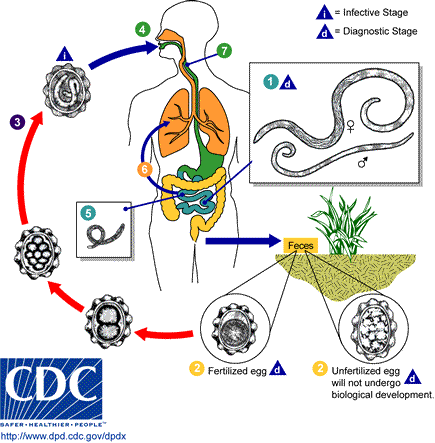Ascariasis pathophysiology: Difference between revisions
Jump to navigation
Jump to search
No edit summary |
No edit summary |
||
| Line 6: | Line 6: | ||
===Life cycle=== | ===Life cycle=== | ||
[[Image:Ascariasis LifeCycle - CDC Division of Parasitic Diseases.gif|thumb|left|260px|Adult worms (1) live in the lumen of the small intestine. A female may produce approximately 200,000 eggs per day, which are passed with the feces (2). Unfertilized eggs may be ingested but are not infective. Fertile eggs embryonate and become infective after 18 days to several weeks (3), depending on the environmental conditions (optimum: moist, warm, shaded soil). After infective eggs are swallowed (4), the larvae hatch (5), invade the intestinal mucosa, and are carried via the portal, then systemic circulation to the lungs . The larvae mature further in the lungs (6) (10 to 14 days), penetrate the alveolar walls, ascend the bronchial tree to the throat, and are swallowed (7). Upon reaching the small intestine, they develop into adult worms (8). Between 2 and 3 months are required from ingestion of the infective eggs to oviposition by the adult female. Adult worms can live 1 to 2 years.]] | [[Image:Ascariasis LifeCycle - CDC Division of Parasitic Diseases.gif|thumb|left|260px|Adult worms (1) live in the lumen of the small intestine. A female may produce approximately 200,000 eggs per day, which are passed with the feces (2). Unfertilized eggs may be ingested but are not infective. Fertile eggs embryonate and become infective after 18 days to several weeks (3), depending on the environmental conditions (optimum: moist, warm, shaded soil). After infective eggs are swallowed (4), the larvae hatch (5), invade the intestinal mucosa, and are carried via the portal, then systemic circulation to the lungs . The larvae mature further in the lungs (6) (10 to 14 days), penetrate the alveolar walls, ascend the bronchial tree to the throat, and are swallowed (7). Upon reaching the small intestine, they develop into adult worms (8). Between 2 and 3 months are required from ingestion of the infective eggs to oviposition by the adult female. Adult worms can live 1 to 2 years.]] | ||
{| align="center" class="wikitable" border="2" cellspacing="0" cellpadding="5" | {| align="center" class="wikitable" border="2" cellspacing="0" cellpadding="5" | ||
Revision as of 20:45, 17 February 2017
|
Ascariasis Microchapters |
|
Diagnosis |
|---|
|
Treatment |
|
Case Studies |
|
Ascariasis pathophysiology On the Web |
|
American Roentgen Ray Society Images of Ascariasis pathophysiology |
|
Risk calculators and risk factors for Ascariasis pathophysiology |
Editor-In-Chief: C. Michael Gibson, M.S., M.D. [1]; Associate Editor-In-Chief: Imtiaz Ahmed Wani, M.B.B.S
Overview
Pathophysiology
Life cycle

| Genus and Species | Ascaris lumbricoides |
|---|---|
| Common Name | Giant Intestinal Roundworm |
| Etiologic Agent of: | Ascariasis |
| Infective stage | Embryonated Egg |
| Definitive Host | Man |
| Portal of Entry | Mouth |
| Mode of Transmission | Ingestion of Embryonated egg through contaminated food or water |
| Habitat | Small Intestine |
| Pathogenic Stage | Adult Larva |
| Mode of Attachment | Retention in the mucosal folds using pressure |
| Mode of Nutrition | Feeding of Chyme |
| Pathogenesis | Larva – pneumonitis, Loeffler’s syndrome;
Adult – Obstruction, Liver abscess, Appendicitis. With Blood-Lung Phase along with Hookworms and Strongyloides stercoralis. |
| Laboratory diagnosis | Concentration methods and Direct Fecal Smear: Kato-Katz |
| Treatment | Albendazole, Mebendazole, or Pyrantel Pamoate |
| Diagnostic Feature - Adult | Female - prominent genital girdle |
| Diagnostic Feature - Egg | Coarse mammilated albuminous coating |